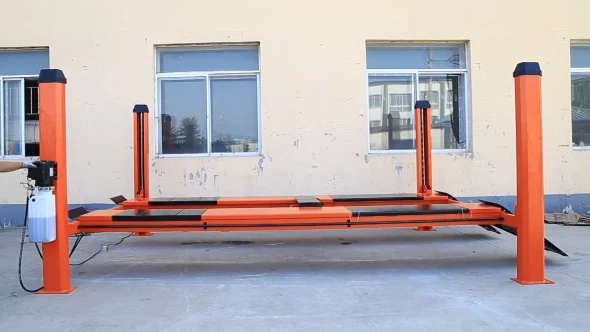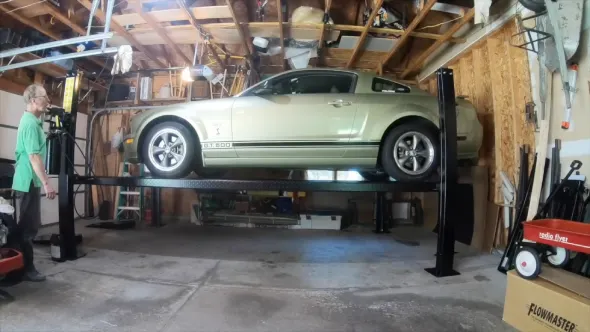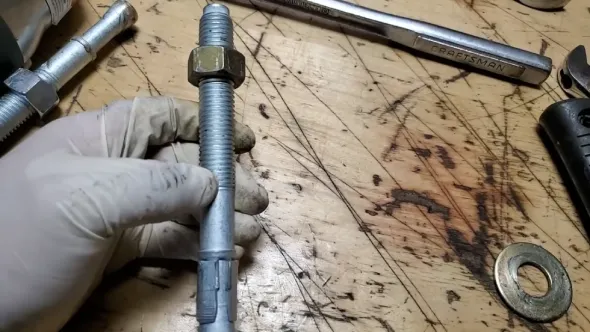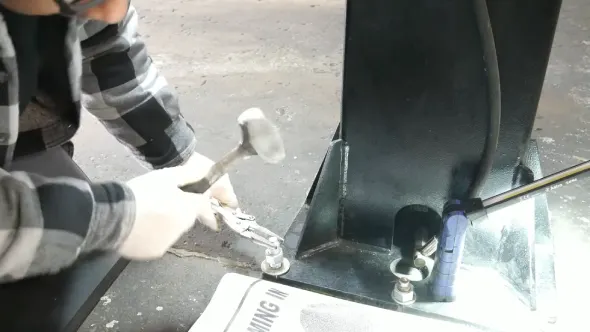Last Updated on March 13, 2023
When deciding on a 4-post lift for your workspace, it’s essential to consider if bolting down the lift is necessary.
While this isn’t always required, a variety of factors come into play when making this determination: weight capacity, wind and earthquake loads, surface type, and even where the lift will be positioned can all play into this decision.
Securing a four-post lift with bolts has numerous benefits. Not only does it ensure stability and safety, but it also aids in meeting local building code regulations. It’s essential to consider all these aspects of bolting down your lift before making an investment. Doing so will help get you the best return on your purchase.
With this in mind, let’s explore why it might be necessary to bolt down a four-post lift.
Do 4 Post Lifts Need to Be Bolted Down: What Influences

Setting up a 4-post lift is more than just a plug ‘n’ play operation. There are several important factors to consider before the installation can be completed. From determining whether it needs to be bolted down.
Here are a few of the most necessary considerations:
Weight Capacity and Stability
When dealing with a 4 post lift, one of the most important factors influencing whether or not they need to be bolted down is the weight lifting capacity. These lifts are designed to support a certain amount of weight, so they must be properly secured to prevent accidents.
The weight capacity requirements vary depending on the manufacturer but typically range between 5,000 to 10,000 pounds for a single lift. Also, stability considerations should be made when installing a 4-post lift on different ground surfaces.
For example, placing the lift on soft ground such as asphalt or gravel. You may consider additional anchoring methods like steel bolts or concrete anchors to ensure maximum stability and security.
Wind and Earthquake Loads
One more thing that could require bolting down the 4-post lift is wind and earthquake loads. To ensure the safety of the vehicle being lifted or serviced underneath it, engineers must perform wind load calculations to determine how much force needs to be applied to secure it against gusts of winds.
Earthquake loads must also be considered when designing buildings that house 4 post lifts. This involves engineering techniques like seismic isolation, which can reduce shaking and vibrations due to nearby traffic or construction activity.
Besides, specific anchoring systems must be implemented in these cases to meet code requirements and function properly during an earthquake event.
Local Building Code Requirements
The local building code requirements in your area should also be considered when determining whether a 4-post lift needs to be bolted down or not. Many codes have different regulations based on what type of building it’s going into.
Automotive shops may have specific specifications regarding how vehicles are supported. While warehousing may require anchoring systems and other safety measures such as fire sprinklers or smoke detection systems.
Aside from that, certain attachment methods must also adhere to local code requirements. Concrete anchors are often used, but steel bolts may also be necessary depending on location and building type.
Types of Surfaces the Lift Is Placed On
Depending on what type of surface you’re putting the 4-post lift on (harder surfaces such as concrete versus softer surfaces such as asphalt or gravel). You may need additional bolting-down solutions for both stability and security reasons.
Harder surfaces tend to provide better support for heavy items like vehicles compared to softer ones like gravel. Despite this, even though hard surfaces may offer more support than softer ones do, they still need some extra reinforcement from bolts or anchors for them to stay secure over time.
Location of the Lift
Another factor influencing whether a 4 post lift needs bolting down is its location. Based on whether you’re indoors or outdoors will determine whether additional anchoring solutions are needed for wind gusts or earthquakes.
Shake-resistant designs can help minimize vibrational forces transferred from nearby traffic or construction activities outside. As an exception, if a lift is installed indoors near other objects with moving parts (like fans), then additional bolting solutions may be needed.
How Safe Are 4 Post Lifts Without Being Bolted Down?

Answering the question of how safe four post lifts are when not bolted down, it can be said that they are still relatively safe. The lifts come with bolt-down anchors installed through each base plate that can be used to secure the lift if needed.
This adds an extra layer of security and ensures the lift remains stable even in more extreme working environments. Without being bolted down, however, there is the risk of some instability or movement during operation, which could increase the risk of accidents and damage.
Therefore, it is recommended to always bolt down your 4-post lift for greater safety and security.
Why Is It An Advantage of Bolting Down a Lift?
A bolted-down four-post lift gives automotive professionals and hobbyists alike greater confidence in their work. With improved stability, precision, and safety assurance, bolting down your 4 post car lift can help you get it right every time.
Bolting down a lift has the following advantages:
- When bolted correctly to the concrete floor, a four-post lift provides a secure base that reduces movement or shifting during use. It makes it safer for technicians to work on the vehicle and protects property.
- With bolting your four post lifts, you get increased support and greater stability, plus longer durability over time. You’ll enjoy the benefits of bolted lifts for many years to come without having to do any repairs.
- Inspection and maintenance of your four-post lift can be done by simply checking the bolts throughout each inspection period. It makes sure potential problems are spotted early on before they become bigger problems later on.
- Feel secure in the knowledge that repairs have been safely and securely completed, knowing your vehicle won’t be going anywhere. By bolting down a lift, you’ll have peace of mind so you can focus on getting back to living.
- Secure your 4 post car lift with bolts for a more stable and cost-effective option. You’ll save money on repairs, replacements, and require less maintenance over time.
What Type Of Bolts Should You Use to Secure a 4-Post Lift?

Anchor bolts are the best option for securing a 4-post car lift. These bolts measure 3/4″ in diameter and 5 1/2″ long, making them ideal for this auto lift. Anchor bolts provide superior grip strength and are designed to be pre-assembled into concrete or masonry substrates before installation.
With the benefits of affordability and corrosion resistance, hook bolts make a perfect choice for installations that require resilience to vibrations, such as 4-post lifts. Utilizing hook bolts opens up opportunities to avoid expensive traditional fasteners while still achieving desired performance outcomes.
For these reasons, anchor bolts should always be used when bolting down a 4-post lift to ensure the stability and safety of the automotive lift and its users.
How Many Bolts Are Required For Properly Securing a 4-Post Lift?
To secure a 4 post lift, it is important to use at least 10-12 screws to secure the lift properly. The screws should be evenly distributed across the posts and tightened down. Using fewer screws will result in an improper installation that could lead to potential safety issues or damage.
It’s recommended to use a power drill with appropriate bits for each screw size to ensure a tight fit, as well as proper torque when tightening them. Apart from that, it’s essential to make sure that any bolts used are corrosion-resistant and of appropriate size for the job.
Note: Always follow the manufacturer’s installation instructions and check all bolts periodically to ensure they remain secure.
How Thick Should Concrete Be For Bolted Down a 4-Post Lift?

To ensure your 4-Post Lift is solidly held in place and won’t budge, it’s crucial to have a base of sturdy reinforced concrete that measures at least four inches thick. This concrete slab thickness ensures that the 4 post lift is securely fastened and won’t move or shift during use.
It is also recommended that reinforced concrete be used for increased durability since it is stronger and more stable than regular concrete.
This strong foundation will guard against damage or cracking from the hefty pressure of using this type of equipment. For extra protection, extend the concrete beyond its normal limits for optimal security.
Note: With most lifts, four inches of thickness ensures they stay secure and in place. But depending on the design and scale of your vehicle lift, it could require a bit more padding for optimal stability.
Attention to Detail Is Crucial for Securing a 4-Post Lift
When it comes to securing your 4-post car lift, overlooking details can have serious consequences. Weight requirements and stability standards must be up to par while adhering to local building codes for you to get the best performance out of your garage or shop setup.
When installing a 4 post car lift, the choice of bolts and anchors, plus knowledge of the required quantity and minimum concrete thickness, is essential to ensure it’s properly mounted. Selecting the right materials for such an installation is key.
With this knowledge in hand, you’ll be able to enjoy a safer and more secure operation with your 4-post parking lift setup.

Useful and lnteresting facts on installation of 4 Post lifts. Thanks.
Our pleasure. 🙂